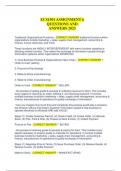Exam (elaborations)
ECS1501 ASSIGNMENT 6 QUESTIONS AND ANSWERS 2023
- Course
- Institution
ECS1501 ASSIGNMENT 6 QUESTIONS AND ANSWERS 2023 Traditional Organizational Functions - CORRECT ANSWER traditional functions within organizations include marketing + sales, supply chain management, accounting & finance, human resources, and more! These functions are HIGHLY INTERDEPENDENT with ...
[Show more]



